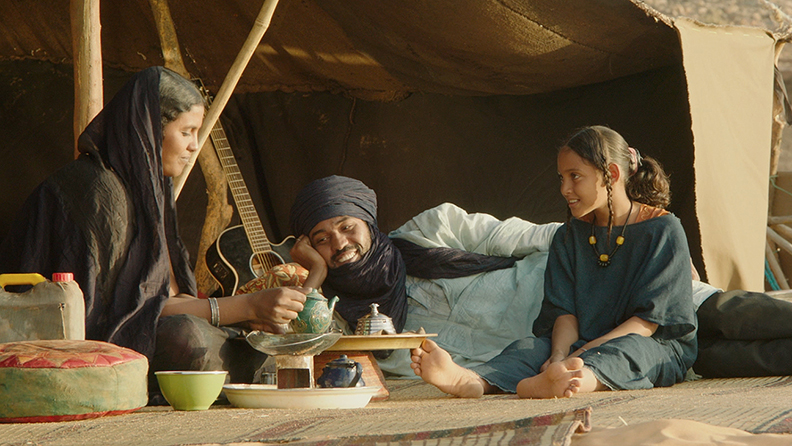Timbuktu
Director: Abderrahmane Sissako
7:30 p.m. Thursday, 8 p.m. Saturday
Oklahoma City Museum of Art
A-
In the wake of aimless gunfire, only the unrecognizable remnants of Malian sculptures remain, growing gradually engulfed by unsettled African sands. This dawning image sets a powerful precedent for Abderrahmane Sissako’s Timbuktu to follow. Fortunately, the film does so in spades, tackling religious reconciliation and cultural deprivation while exemplifying the beauty in non-violent resistance. Detailing the plight of an elder city during the occupation of Mali by radical Jihadists, Timbuktu places a human face upon both victim and prosecutor, emitting a sense of intimacy on par with Asghar Farhadi’s A Separation from 2011. Propelling the film most, however, is an impeccable sense of timing woven in tandem with Sofian El Fani’s simple yet impactful camerawork. Timbuktu lulls you into a consideration of life and spirituality, reiterating that the overzealous pursuit of the latter may compromise the former.
Spouses Kidane (Ibrahim Ahmed) and Satima (Toulou Kiki) lead a quiet life on the sand dunes of Timbuktu, herding cattle with the aid of their daughter Toya (Layla Mohamed) and Kidane’s nephew Issan (Mehdi Mohamed). An impending wave of religious radicalism and the harsh execution of Sharia law has pushed Kidane’s neighbors out of the region, but the man’s unwavering faith (and stubbornness) has left his family grounded. Within Timbuktu’s center, initially bumbling Jihadists begin to evoke substantially crueler forms of discipline against any villager refusing to comply with the new authority. Among the prohibitions are a ban against women unveiled and in colorful clothing, playing football competitively, and performing music that harkens to Mali’s presumptuously determined sacrilege. After a violent altercation leads to Kidane’s arrest, the protagonist is forced to reconcile divine law with the debilitating love for his family and home.
Timbuktu is visually striking, conveying a cinematic symmetry that echoes shades of Abbas Kiarostami’s Certified Copy. This notion is further enforced by nearly identical opening and closing frames; though the film recognizes an attempt at a social overhaul, the work aesthetically contends for consistency. Two scenes in particular exemplify the concept. For the first instance, a woman fashioned with colorful, Malian garb blocks a Jihadist truck piled with armed gunman with her arms outstretched across a narrow alley, the camera slowly shifting downward as if to emulate the figure’s ascent. Later and after a pivotal altercation between Kidane and a local fisherman, the camera idles for several moments as a river stretches into the center of dusk. On each bank two men, almost microscopic within the frame, struggle to remove themselves from bloodied waters. On the left side, one character presses forward successfully, while the other collapses before escaping the shot on the opposing edge. Again, these aesthetics weave a tale more compelling than most dialogue.
That’s not to say speech in Timbuktu is superficial. On an inherent level, a variety of languages — including French, Arabic and Bambara — provide a voice to the communal struggle. Variations between vernacular often illuminate (and occasionally bridge) the schism between the native Malians and controlling Jihadists. In one instance, Abdelkerim (Abel Jafri), on the senior officers of the occupying force, lectures a couple young natives on their evidence of slang usage, insisting that their holy mission can do without any of the “yo dog” jargon.
Timbuktu’s performers shine tremendously, with particular attention drawn to Ahmed’s role. Likewise, many members of the cast reflect an irrefutable authenticity with enough personal tang to alleviate any face-in-the-crowd disposition. Despite the city’s oppression, the setting breathes with the life of a complex and beautiful culture. Facially, many of the performers exhibit dismay but convey brief moments of optimism when called for, such as playing spiritual songs and brandishing the tapestries of local flavor.
Very few things in Timbuktu came off as jarring, but one of the most ironically noticeable is the exceptional cinematography. At times, things seem to carry on a bit too long, trailing far beyond any didactic purpose and following into a bout of redundancy and stagnation. These scenes are few and far between, but when they do occur they leave you anxious. The film could have benefited from a bit more context, but the minimalist narrative should spur more intrigue than disappointment.
Timbuktu is a helluva period piece, despite how recent said period was. Like the fractured idols at the film’s opening, the work serves as a testament to the persistence of culture. And like the nature of the savannah in which the film resides, Timbuktu is a dauntless piece of art.





